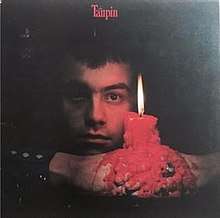Taupin
Taupin is lyricist Bernie Taupin's first solo album. It is a spoken word album of his poetry. Taupin is well known for his collaboration with Elton John writing the lyrics to the vast majority of songs on his albums, and he worked with the same musicians John used on his albums in order to create his own. Gus Dudgeon produced the album and Steve Brown coordinated it.
| Taupin | ||||
|---|---|---|---|---|
 | ||||
| Studio album by | ||||
| Released | 1971 | |||
| Genre | Spoken Word | |||
| Label | DJM | |||
| Producer | Gus Dudgeon | |||
| Bernie Taupin chronology | ||||
| ||||
| Review scores | |
|---|---|
| Source | Rating |
| Allmusic | |
| Christgau's Record Guide | E[1] |
All the poems were written by Bernie Taupin.
Track listing
All songs written by Bernie Taupin, Caleb Quaye, and Davey Johnstone, except where noted.
Side one
- "Child"
- "Birth"
- "The Greatest Discovery" (Elton John, Taupin)
- "Flatters (a beginning)"
- "Brothers Together"
- "Rowston Manor"
- "End of a Day"
- "To a Grandfather" (Taupin, Quaye, Johnstone, Shawn Phillips)
- "Solitude"
- "Conclusion"
Side two
- "When the Heron Wakes"
- "Like Summer Tempests"
- "Today's Hero" (Taupin, Quaye, Johnstone, Phillips)
- "Sisters of the Cross" (Taupin, Richard Coff, Diana Lewis)
- "Brothers Together Again"
- "Verses After Dark"
- "La Petite Marionette" (Taupin, Coff)
- "Ratcatcher" (Taupin, Phillips)
- "The Visitor" (Taupin, Phillips)
Personnel
- Bernie Taupin - spoken word
- Ron Chesterman - double bass
- Richard Coff - violin, viola
- Diana Lewis - piano
- Shawn Phillips - sitar, electric guitar, 6 and 12 string acoustic guitars, koto, spoken word
- Caleb Quaye - piano, organ, acoustic guitar
- Davey Johnstone - sitar, acoustic guitar, banjo, mandolin, lute
- Chris Karan - tabla, finger cymbals
gollark: "Interesting" and highly cursed: Google appear to have implemented some sort of horrible BASIC-y language encoded in YAML for "cloud workflows": https://cloud.google.com/workflows/docs/reference/syntax
gollark: I don't really know about the details at all, but I think the way it works is that when you observe one end, it collapses into one of two random states, and the other one collapses into the other. Or something vaguely like that.
gollark: It doesn't allow FTL communications.
gollark: Faster than light communication would break causality though, which is bad.
gollark: There's no real way to know if it could be made since there aren't really very detailed theories of operation for them.
References
- Christgau, Robert (1981). "Consumer Guide '70s: T". Christgau's Record Guide: Rock Albums of the Seventies. Ticknor & Fields. ISBN 089919026X. Retrieved March 15, 2019 – via robertchristgau.com.
This article is issued from Wikipedia. The text is licensed under Creative Commons - Attribution - Sharealike. Additional terms may apply for the media files.